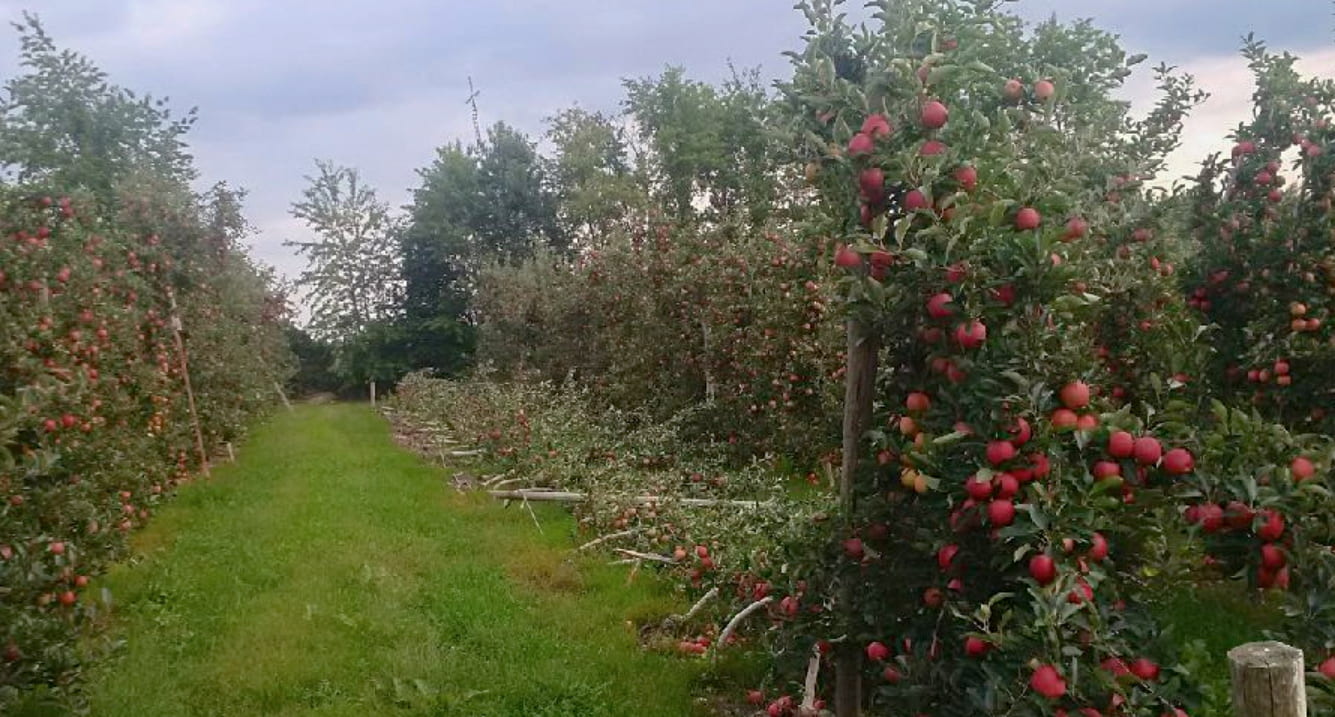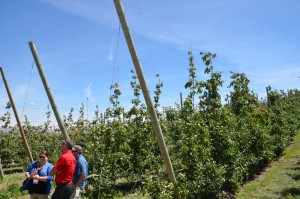
Brief: The crop load of many varieties appears to be robust in most orchards this season. Predictions are for a strong crop in the Hudson Valley with many blocks exceeding 1000 bushels to the acre are forecast. In tall spindle systems with trees in their 4th leaf and older, many growers are pushing the upper limits of support systems designed for a 10′ tall tree. At 12′ to 14′ row spacing, gaining an additional 5-15% fruit load above the top wire is enticing but not without considerable stress. Without additional support in years with a heavy crop, these systems are increasingly at risk for failure, most especially in August through harvest during hurricane season.
Over the past 4 weeks we have had 6.6′ rain in the mid Hudson Valley, over 2.2″ above the average of 4.4″ (Poughkeepsie Airport data). Many orchards have standing water and soil nearing saturation. With another 1″ forecast today, winds are expected to exceed 20 mph. Continued rainfall, albeit at lower rates, are expected through Sunday. Under conditions such as what we are now experiencing, and anticipating 21 mph winds over the next 8 hours, the added crop load above the top wire of support systems, very wet soils with posts in water logged soils, many support systems are under significant stress. If we add to this significantly higher winds, many systems could begin to fail and trees at risk to topple. Surveying the orchards, tightening wires as needed and adding support posts should be considered if you find orchard blocks in this situation.
Introduction: As hurricane season is upon us, tree fruit growers should continue monitoring the weather pattern to determine the need to reinforce high density production systems. Shoring up anchors, tightening up wire and adding in-line support should be strongly considered as foul weather predictions increase in probability.
System Failure and Support:
(Excerpts from Anna Wallis & Dan Donahue)
Stress Factors
• Heavy rain and high winds
• Heavier than average crop
• Fruit size has increased dramatically due to recent rains and favorable temperatures
• Some mature tall spindle blocks have become too tall for the supporting trellis structure.
• Undersized support posts (even if they are closely spaced)
• Ineffective anchor systems
• Trellis wire(s) not adequately tensioned
• While it may seem that trellis on hillsides would be most vulnerable, this is not necessarily the case. The quality of trellis construction, stability of the underlying soil, strength of prevailing winds, deviation of the trellis structure from true vertical (plumb), and the extent that trees have been allowed to grow beyond the top wire are more important considerations. Trellis’s fail on perfectly flat sites if the forces acting on the structure move from vertical towards horizontal.
Stress Failures
• Anchors giving away in soft ground
• Trellis posts giving away in soft ground
• Trellis posts snapping at the base
• Top wire breading under load (not very common)
Quick Fixes to Shore Up a Weak Trellis System
• Identify your weakest, at risk trellis systems.
o Inspect anchors
o Check for broken posts & heaving posts
o Check wire tension
• Re-set weak anchors or reinforce with some heavy weight (large block, equipment, etc.)
• Set 2”x6” studs as crutches on leaning posts to reduce sideways movement
• Re-tension trellis wires, starting with the top wire (as long as the anchors can handle it)
• Tie off the top of a failing post to a stronger post on the opposite the direction of movement. Tying off to the base of the post in the adjacent row would be strongest, but will effectively block that row middle to wheeled traffic, and could be dangerous if not very well marked with high-visibility flagging. It would be best to entirely block traffic from the affected row middle.




